
Every week, Laura Lieb and Brooklyn White talk with people who have received terrible news. “Someone will call and say, ‘I was just told I have Parkinson’s disease in a 20-minute visit with my doctor, and I don’t know what to do next,’” Lieb said. “That is not uncommon.”
For Lieb and White, coordinators of the American Parkinson Disease Association’s Information and Referral Center at UAB, the mission is to help patients and families pick up the pieces and find a way forward.
UAB has partnered with the APDA since 1978 to host the I&R Center. It offers support for patients, caregivers, health care providers and community members, whether or not they are UAB patients, by phone (205-934-9100), email (
The center offers educational programs and resources, along with a comprehensive network of allied health care professionals; physical, occupational and speech therapists; support group programs; exercise and wellness classes; and information on research and open clinical trials.
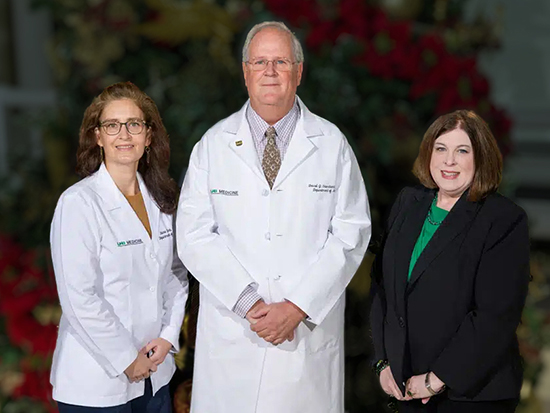 Coordinators Laura Lieb, CRNP, and Brooklyn White (left and right) with David Standaert, M.D., Ph.D. (center), medical director of the American Parkinson Disease Association’s Information and Referral Center at UAB.“When someone is recently diagnosed, we want to give them all the resource options,” said Lieb, a certified registered nurse practitioner with a master’s degree in public health. For instance, “we have curated all the movement and exercise classes in the state that we are aware of.”
Coordinators Laura Lieb, CRNP, and Brooklyn White (left and right) with David Standaert, M.D., Ph.D. (center), medical director of the American Parkinson Disease Association’s Information and Referral Center at UAB.“When someone is recently diagnosed, we want to give them all the resource options,” said Lieb, a certified registered nurse practitioner with a master’s degree in public health. For instance, “we have curated all the movement and exercise classes in the state that we are aware of.”
“One of the best things we can do is to plug those newly diagnosed with Parkinson’s into one of our upcoming Good Start educational programs,” White said. The Parkinson’s Good Start program is a four-hour class that takes place several times a year throughout Alabama. It is also hosted quarterly virtually over Zoom in a two-part series. “With APDA, we have built a program that provides the most critical, need-to-know information for those who have been newly diagnosed,” White said. The program provides a Parkinson’s overview, teaches participants how to build their health care teams and connects them to many local resources for Parkinson’s specifically in their area. “I wish we had something like this available when my dad was diagnosed in 2012,” White said. “It would have been a game-changer in his journey with PD.”
Steve Sain, who was diagnosed with Parkinson’s in 2018, recently attended the Good Start program that was hosted in Opelika, Alabama. “I wanted to check out the program so that I could better serve my own support group that we recently launched in Alexander City,” Sain said. “This program is phenomenal in that it provides exactly what is most critical to know up front about Parkinson’s, setting a foundation for how you can grow to learn more.”
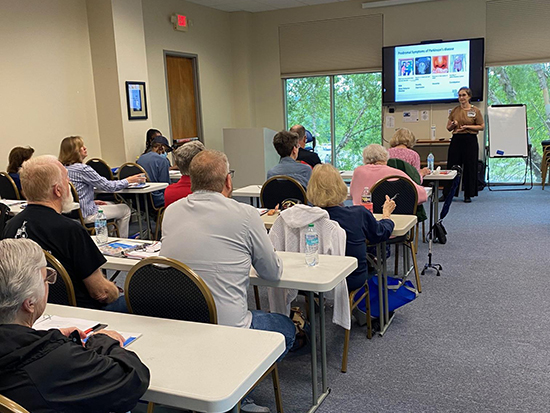 Lieb leading a Good Start class, which provides the most critical, need-to-know information for those who have been newly diagnosed. It is offered several times a year throughout Alabama and quarterly over Zoom.What are some other important things for newly diagnosed patients and their care partners to know? We asked Lieb, White and Sain to share their thoughts.
Lieb leading a Good Start class, which provides the most critical, need-to-know information for those who have been newly diagnosed. It is offered several times a year throughout Alabama and quarterly over Zoom.What are some other important things for newly diagnosed patients and their care partners to know? We asked Lieb, White and Sain to share their thoughts.
1. Exercise is critical
“We still have yet to fully understand how important exercise is and to what degree,” Lieb said. “But it is clear that it is one of the most important things patients can do.” Many clinicians and researchers feel that exercise may even slow the progression of the disease, Lieb points out. “And it helps with all these other non-movement symptoms, including sleep and depression and more,” she said. “There is not a pill that does that. You really can’t argue with the benefit of exercise.”
“Everyone knows that ‘yeah, yeah, I should exercise,’” Sain said. “But when you have Parkinson’s, it has all of a sudden become critical. I let people with Parkinson’s know, ‘try not exercising for a while and you will see what happens.’”
Sain works out with a personal trainer twice a week and walks several miles around his neighborhood with a group of men three days a week — along with regular sessions on his drum kit. There are days when he, like everyone else with Parkinson’s, just feels like staying in bed. But he has a graphic analogy he uses to motivate himself and others. “Parkinson’s disease is like molten lava,” Sain said. “It moves slowly, but it destroys everything it touches. You have to keep moving to stay ahead of it.”
Lieb and White help connect callers to classes in their area, such as free Parkinson’s exercise classes at the Birmingham-area YMCAs. Another popular option in the Birmingham area is a boxing class called the PD Fight Club, which combines strength training, balance, reaction time and overall fitness. It attracts participants from their 30s to their 90s. “Everyone loves the exercise, but they are really thriving off the community,” Lieb said.
Plus, throwing punches against a padded bag, an exercise that Sain works on with his trainer, “helps you get out some of your frustration,” he said. “You can hit something, and no one gets hurt.”
2. Get into a support group
Another important step, Lieb and White say, is to become involved with a support group as soon as possible.
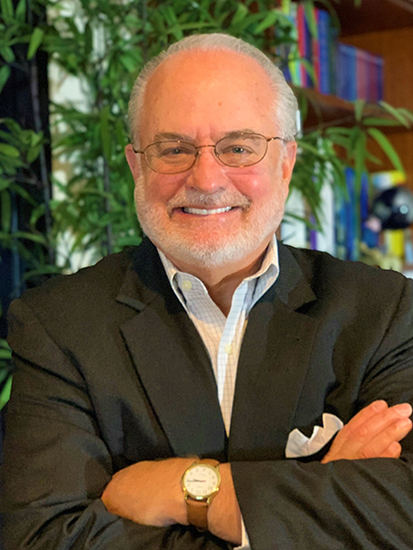 Steve Sain, who was diagnosed with Parkinson's disease in 2018, is a big believer in the the value of getting involved in a support group. "There is good camaraderie," he said. "These aren't pity parties. It’s mainly sharing of information to help one another.”Image courtesy Steve Sain“You are able to learn so much more when you surround yourself with other people who are experiencing the same issues and have found things that help,” Lieb said.
Steve Sain, who was diagnosed with Parkinson's disease in 2018, is a big believer in the the value of getting involved in a support group. "There is good camaraderie," he said. "These aren't pity parties. It’s mainly sharing of information to help one another.”Image courtesy Steve Sain“You are able to learn so much more when you surround yourself with other people who are experiencing the same issues and have found things that help,” Lieb said.
“We have more than 20 in-person groups that meet throughout the state,” White said. “And I facilitate two virtually — one for care partners and one for people living with Parkinson’s disease.”
Sain began attending the Sylacauga support group after he was diagnosed seven years ago. He learned so much, and found the experience so valuable, that he started the Lake Martin Support Group in Alexander City, even as he continues to attend the Sylacauga group. “I figured it’s my turn to pay it forward,” Sain said. He has a monthly guest spot on an Alexander City TV talk show called the Front Porch — a platform he uses to share what he has learned and recruit new members to the group.
What is so helpful about support groups? They “are not pity parties,” Sain emphasized. “If anything, we poke fun at each other. There is good camaraderie. It’s mainly sharing of information to help one another.” Some of that information is “what I would call hacks,” Sain said. “Things you would do without thinking if you didn’t have Parkinson’s, like getting out of bed, can be a struggle if you are not on your medications properly. There are certain ways to grab the side of your mattress and pull yourself to the edge of the bed, for instance — things they teach you in occupational therapy that help.”
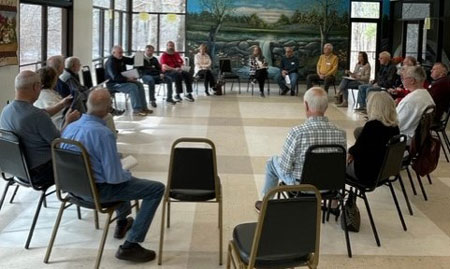 Members of the Lake Martin Support Group at their first public meeting. Image courtesy Steve SainMembers can also give their input on common questions. “One of the biggest is how to distinguish between aging and Parkinson’s,” Sain said. “’It hurts when I do this. Is that aging or Parkinsons?’ If you go around the room and see a theme across the responses, you have a good idea if you may need to step it up with your Parkinson’s treatment or if it’s just a part of growing old.”
Members of the Lake Martin Support Group at their first public meeting. Image courtesy Steve SainMembers can also give their input on common questions. “One of the biggest is how to distinguish between aging and Parkinson’s,” Sain said. “’It hurts when I do this. Is that aging or Parkinsons?’ If you go around the room and see a theme across the responses, you have a good idea if you may need to step it up with your Parkinson’s treatment or if it’s just a part of growing old.”
Recently, White started a new virtual support group that meets over Zoom monthly. The goal of the group, called PD Thrive, “is to strike the balance between providing educational resources from Parkinson’s experts while giving an opportunity to build camaraderie,” White said. Co-facilitated by White and Katie Fordham, who was diagnosed with Parkinson’s at age 36 in 2019, PD Thrive provides access to support for those who do not have a local support group near them, or who have time conflicts with their local support group. “After we provide the educational session and resources, we break out into smaller Zoom rooms based on like scenarios — age, gender, etc. — allowing us to support one another in similar situations,” White said. “It’s amazing what we can do to build community through new technologies now.”
Support groups “can also be very beneficial for family members and care partners,” White pointed out. UAB facilitates and hosts a virtual care partner-only session, which is available on the first Monday of each month over Zoom at 7 p.m. “This group has really grown close and welcomes anyone new — providing practical tips for making care easier, but also supporting each other emotionally as PD advances,” White said. “This is a disease that relies heavily on care partners and family members. By providing practical tips, as well as educational resources about caregiver burnout and stress, we are helping them understand the importance of respite and how they can best serve the loved ones in their care.”
3. Find your new life “outside the pill box”
Treatment is clearly very important, Lieb said, “but you also need to look at ‘how am I going to keep on living, beyond just going to appointments?’” She calls it “living outside the pill box,” which is really about “incorporating a proactive approach,” she said. That includes things like exercise and finding community, but it also involves developing a new mindset.
“Living well with Parkinson’s disease is possible,” Lieb said. “It varies with each person. If you think about the alternative, dwelling on all the things that aren’t going well, that really doesn’t help.”
“Living well with Parkinson’s disease is possible,” Lieb said. “It varies with each person. If you think about the alternative, dwelling on all the things that aren’t going well, that really doesn’t help.”
“We see that lifestyle management can have a huge impact in slowing progression,” White said. “The people truly connected in the programs are doing fairly well.”
For Sain, who devoted decades to building a successful engineering firm, his new mindset included taking time to do the things he never could get to because of his schedule. One of his first decisions after getting his diagnosis was to buy the motorcycle he always wanted: a Triumph inspired by his teenage hero, movie star Steve McQueen. He has also traveled the world with his family and, when they cannot make it, by himself. “My mantra is, ‘Do it while you still can,’” he said.
“I’ve known Steve for some time,” White said. “He embodies the perfect Parkinson’s patient — making exercise and living a full life with Parkinson’s a priority. I believe the reason he is coping so well with his diagnosis and managing symptoms well for so many years is because of his great attitude and willingness to do the hard work to fight back against Parkinson’s.”
4. Parkinson’s is always changing
Most people base their impression of what Parkinson’s will be like on personal experiences — what a grandmother went through, for example. But research advances mean treatment approaches are always evolving, Lieb says. One of the benefits of contacting the Information & Referral Center is you can always get an update on the latest details.
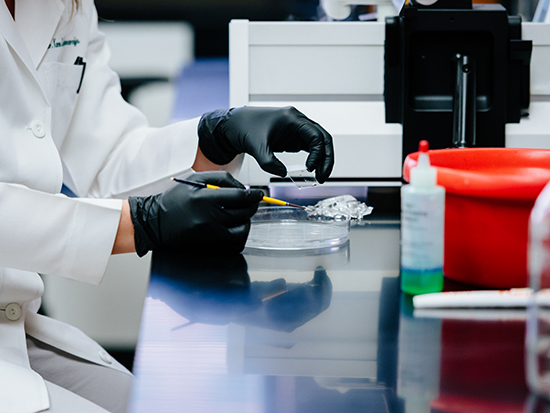 Research at UAB and elsewhere has led to more targeted, precise treatments for Parkinson's disease. “So much has changed, just within the last few years,” Lieb said.“The understanding of the disease has evolved to understanding how significant the non-movement symptoms are,” Lieb said. For example, “the effects of Parkinson’s disease on sleep are pretty significant,” and care at centers such as UAB now involves sleep disorder specialists.
Research at UAB and elsewhere has led to more targeted, precise treatments for Parkinson's disease. “So much has changed, just within the last few years,” Lieb said.“The understanding of the disease has evolved to understanding how significant the non-movement symptoms are,” Lieb said. For example, “the effects of Parkinson’s disease on sleep are pretty significant,” and care at centers such as UAB now involves sleep disorder specialists.
“So much has changed, just within the last few years,” Lieb said. Treatments are becoming more targeted and precise, for instance. With deep brain stimulation, a treatment that has been widely used at UAB for the past few decades, increased precision means that patients can avoid some of the side effects that used to accompany therapy.
About a decade ago, the FDA approved pimavanserin, marketed as Nuplazid, which was the first medicine for treating psychosis associated with Parkinson’s, Lieb said. “Paranoia and psychosis are not uncommon symptoms, and we never had a treatment until recently.”
Just recently, a subcutaneous delivery method became available for the most commonly used Parkinson’s medication, carbidopa levodopa. “It provides a sustained, steady dose throughout the day — kind of like an insulin pump for people with diabetes — so patients do not have to be thinking about taking medicine every three hours,” Lieb said. “Keeping up with that is quite a challenge for patients and their caregivers, so that development has had quite a great impact on quality of life.”
5. Do you have a question about Parkinson’s disease treatment, research or resources?
Lieb’s biggest piece of advice: Reach out today by phone at 205-934-9100, email at